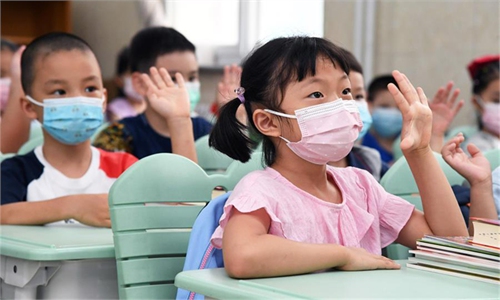
Babies participate in a baby crawling contest at a shopping center in Daxing District, Beijing, capital of China, Sept. 13, 2020. (Xinhua/Li Xin)
Some Western media outlets seem to have been digging weekly topics to prove China is "collapsing." And they apparently seized one thing to hype this week - China's population drop. Pretending to care about China, these media are actually peddling one narrative - the "demographic crisis" means faltering economy and stagnated development. They will be disappointed, again. China is far from the need to be panic about its population.Some of those reports come to one conclusion: China will be unable to surpass the US economically. The New York Times went further. In an article entitled "China's Decline Became Undeniable This Week. Now What?" it claims that China is increasingly likely to grow old before it gets rich; a declining population generally correlates with economic decline, and its weakness will ripple through the world economy.
It is funny that when the same phenomenon once occurred in the US, European countries, or Japan and South Korea, Western media was not worried.
The history of Western developed countries has proved that when societies become richer with better living standards, their fertility rates tend to decline. In his book, 2030: How Today's Biggest Trends Will Collide and Reshape the Future of Everything, Mauro F. Guillen, dean of the Cambridge Judge Business School, made a generally prediction for the globe: By 2030 we will be facing a baby drought.
When it happens in the West, numerous reasons, including access to and duration of higher education, employment opportunities, and the rise in individualism, are listed. But when it takes place in China, it is called a "crisis," or even a "time bomb." The narrative exposes Western media's ill logic - everything is fine at home, but everything is not fine in China. The logic comes from ideological stereotypes, from their habit to seek proof with already-finalized viewpoints, and from their anxieties, Shen Yi, a professor at Fudan University, told the Global Times.
Data released by the National Bureau of Statistics of China (NBS) showed that the population in the Chinese mainland recorded negative growth for the first time in 61 years, decreasing by 850,000 in 2022. In the same year, the number of births was 9.56 million, marking the first time since 1950 that new births have fallen below 10 million. The figures dropped indeed, but are still much larger than that of the US - approximately 3.6 million annual births in recent years.
China's status as one of the most populous countries in the world will not change. A slight decline in population will not lead to stagnation of China's GDP growth and it will not become a stumbling block to surpass the US economy. If China's development slows down, population decline will not be the top reason.
Chinese scholars and ordinary people have long known that this was coming. Yuan Xin, a professor from the Institute of Population and Development at Nankai University's School of Economics, told the Global Times that China's national population is currently hovering around the zero-growth stage.
Some young people decided to delay pregnancy due to the pandemic. It is thus possible to see a population growth rebound in two or three years to come, said Yuan.
According to UN's World Population Prospects 2022, China's population will still remain larger than 1.3 billion by 2050. That is by no means a small population size. Yuan noted that in the next 30 years, China's population decrease will be mild, and China will still be a huge market. With rising incomes and consumption power, its enormous potential will remain inestimable.
He also stressed the leapfrog progress in China's education. The enrollment scale of China's colleges and universities is constantly expanding. Reports show that Chinese higher education institutions currently pump out about 10 million graduates annually. It means China's population advantage is shifting from quantity to quality. Relying on the pure number of population and staying in the labor-intensive industrial chain will not be China's future path.
Granted, factors that caused low fertility rate, such as rapid increase in the cost of raising children, should not be overlooked. This is a challenge. And the Chinese government has already come up with ways to deal with it. In July 2021, China released a decision allowing a couple to have three children and rolled out a slew of support measures, ranging from tax breaks to more nurseries and flexible work leave to encourage births. During the 20th National Congress of the Communist Party of China, China stressed that it will establish a policy system to boost birthrates and bring down the costs of pregnancy and childbirth, child rearing and schooling.
China does not lack relevant strategic planning or policy guidance. According to Yuan, what's important is to solidly implement those policies and measures, in an attempt to slow down the pace of population decrease. There will be challenges for sure, but are far less dim than how Western media put it.
Badmouthing China has never ceased in the West over the past decades. None of them influenced China. Likewise, those who pin "crisis" label on China will find their crystal ball wrong again. Facing a population challenge, China will respond in its own way, like how it comes to where it is today, through all ups and downs.


